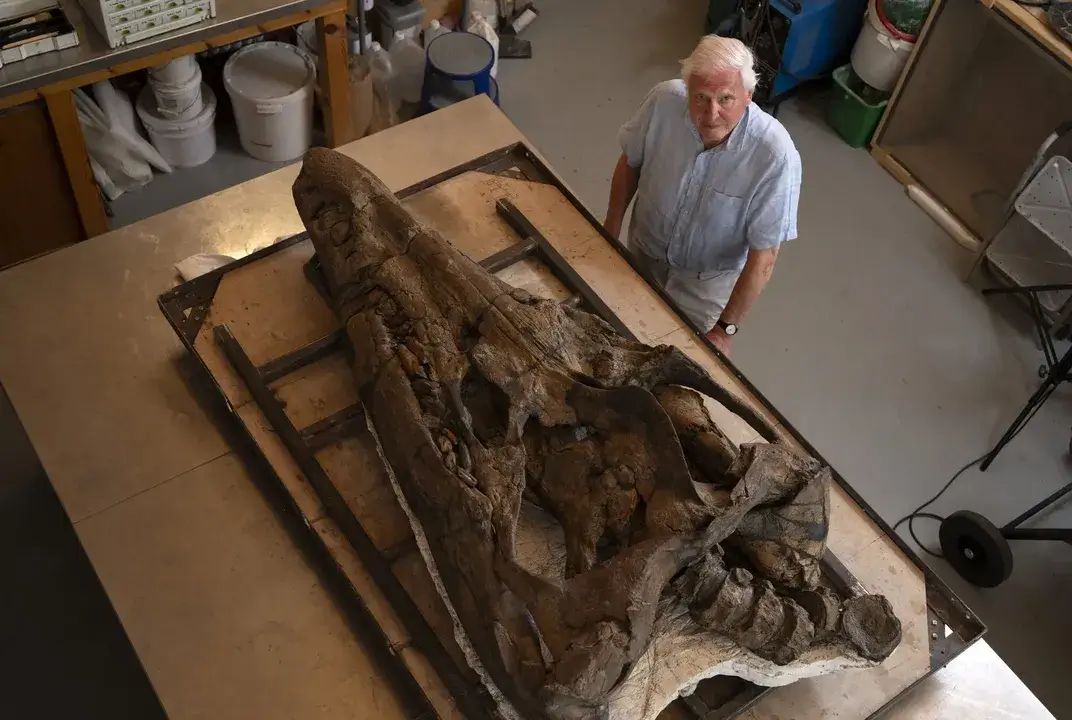
Fossil Hunters Uncover Prehistoric ‘Sea Monster’ Skull At A U.K. Beach
The six-and-a-half-foot-long pliosaur skull was excavated from a rock cliff in England and may belong to a new species, scientists say
By: Margaret Osborne | Smithsonian
Fossil hunters have discovered one of the most intact pliosaur skulls ever found, which they uncovered on a beach in Dorset, United Kingdom. At six-and-a-half feet long, the skull of the prehistoric “sea monster” hints at the size of some of the largest pliosaur adults, which could grow up to about 50 feet.
“It’s one of the best fossils I’ve ever worked on. What makes it unique is it’s complete,” local palaeontologist Steve Etches tells Jonathan Amos and Alison Francis of BBC News, which first reported the story. “The lower jaw and the upper skull are meshed together, as they would be in life. Worldwide, there’s hardly any specimens ever found to that level of detail. And if they are, a lot of the bits are missing, whereas this, although it’s slightly distorted—it’s got every bone present.”
In spring 2022, fossil enthusiast Phil Jacobs spotted the tip of the ancient sea creature’s snout as he was strolling along the Jurassic Coast, a 95-mile-long UNESCO World Heritage Site heralded as one of the planet’s best spots to find fossils. The fragment was located at the base of a towering rock cliff, presumably having fallen from the rock above.
The massive find was too heavy for a single person to carry, so Jacobs called Etches, and the two of them created a makeshift stretcher to haul the fossil away. Immediately, both were “quite excited, because its jaws closed together, which indicates [the fossil] is complete,” Etches tells CNN’s Issy Ronald.
But the rest of the skull was nowhere to be seen. So, the fossil hunters used some drones to examine and map out the towering cliff face above.
Frozen In Time: 8 Most Well-Preserved Fossils Ever Discovered
The drones pinpointed a location about 36 feet from the ground as the likely spot where the rest of the skull was embedded. Guided by that insight, the team began a complicated excavation that involved rappelling down the cliff face, per BBC News. They spent a painstaking three weeks chiselling the fossil out of the side of the cliff while suspended in mid-air.
The team’s discovery, excavation and ongoing scientific investigation will be featured in a BBC documentary, “Attenborough and the Jurassic Sea Monster” with David Attenborough, which will air on PBS in February.
Pliosaurs were gigantic marine reptiles that lived during the Jurassic and Cretaceous periods about 65.5 million to 200 million years ago. These short-necked creatures were not dinosaurs, rather, they belonged to the order Plesiosauria, along with their long-necked plesiosaur relatives. With a large head, four turtle-like flippers and a row of 130 massive, sharp teeth, pliosaurs were fierce predators with the ability to kill prey in a single bite. Researchers believe one species, Pliosaurus kevani, may have had a bite force of nearly 50,000 newtons—almost enough to bite through a car, according to a video from Steve Etches’ museum, the Etches Collection, located in Kimmeridge, England.
CT scans revealed the Dorset pliosaur had sensory pits located on its snout that would have helped the animal hunt by detecting changes in pressure, writes New Scientist’s David Stock. A parietal eye, or “third eye,” atop the creature’s head may have helped it detect light as it swam through murky waters.
Additionally, the fossil had a large sagittal crest—the ridge of bone that protrudes upward and runs along the middle of the skull, per the publication. This is the site of a muscle attachment that controls the crushing lower jaw. Carnivores and omnivores tend to have more pronounced crests, while herbivores may lack an obvious ridge.
“The height of the crest might be an indication of differences between the male and female sexes,” Judyth Sassoon, a pliosaur expert at the University of Bristol in England, tells New Scientist, adding that “it’s very likely a new species.”
Etches will put the skull on display in his museum next year, per the BBC. And he has plans to investigate whether more of the massive reptile’s bones lie embedded in the Dorset cliffs.
“I stake my life the rest of the animal is there,” he tells BBC News. “And it really should come out, because it’s in a very rapidly eroding environment. This part of the cliff line is going back by feet a year. And it won’t be very long before the rest of the pliosaur drops out and gets lost. It’s a once in a lifetime opportunity.”
* * *
NEXT UP!
Scientists Find Out If A Lashing Dinosaur Tail Could Generate A Sonic Boom
Every once in a while, scientists embark on a study to test some weird and wacky hypothesis that makes you wonder why. But let’s indulge them; it can be fun
A new study from a team of palaeontologists and aerospace engineers has simulated a dinosaur‘s tail as it lashes about, all to see whether long-necked sauropods could whip their appendages faster than the speed of sound – quick enough to produce the crack of a small, supersonic boom.
Previous research has suggested the dinos could, if their tails had a bullwhip-like structure adding length. If that were true, these herbivorous dinosaurs might have used their tails to defend themselves against predators or nosy neighbours.
* * *
READ MORE: A Dinosaur Killed On The Day of The Fatal Asteroid May Have Been Discovered
Read more on Palaeontology: Giant ‘Death Shadow’ Dinosaur Found In Argentina Is Largest Megaraptor On Record
Telegram: Stay connected and get the latest updates by following us on Telegram!
We’d love to hear from you! If you have a comment about this article or if you have a tip for a future Collective Spark Story please let us know below in the comment section.
